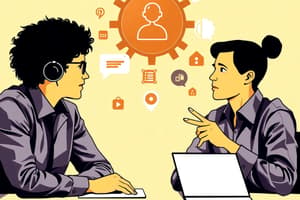Podcast
Questions and Answers
Which type of media is characterized by high levels of information exchange and involves multiple forms of media?
Which type of media is characterized by high levels of information exchange and involves multiple forms of media?
- Rich Media (correct)
- Traditional Media
- Digital Media
- Lean Media
What type of power is derived from an individual's formal position within an organization?
What type of power is derived from an individual's formal position within an organization?
- Legitimate Power (correct)
- Expert Power
- Referent Power
- Coercive Power
Which approach analyzes how information and communication technologies (ICTs) affect power dynamics within organizations?
Which approach analyzes how information and communication technologies (ICTs) affect power dynamics within organizations?
- Critical Approach (correct)
- Symbolic Approach
- Traditional Approach
- Structural Approach
What concept refers to the process of challenging dominant power structures?
What concept refers to the process of challenging dominant power structures?
In Media Richness Theory, which of the following factors should be considered when selecting a communication channel?
In Media Richness Theory, which of the following factors should be considered when selecting a communication channel?
Which source of power is based on specialized knowledge that others may not possess?
Which source of power is based on specialized knowledge that others may not possess?
Structural Power within organizations often favors which group?
Structural Power within organizations often favors which group?
Which of the following best defines hegemony in an organizational context?
Which of the following best defines hegemony in an organizational context?
What is a primary reason for competition in organizations?
What is a primary reason for competition in organizations?
Which of the following is NOT a step in preparing for a diagnostic process?
Which of the following is NOT a step in preparing for a diagnostic process?
What influences the effectiveness of decision-making within organizations?
What influences the effectiveness of decision-making within organizations?
What does 'Surface Level Diversity' focus on?
What does 'Surface Level Diversity' focus on?
Which of the following describes 'Deep Level Diversity'?
Which of the following describes 'Deep Level Diversity'?
What is a potential barrier to research in organizations?
What is a potential barrier to research in organizations?
What is the primary focus of Talent Management in organizations?
What is the primary focus of Talent Management in organizations?
Which of the following is an argument for promoting diversity within organizations?
Which of the following is an argument for promoting diversity within organizations?
Which type of media is designed for straightforward communication with fewer cues and limited feedback?
Which type of media is designed for straightforward communication with fewer cues and limited feedback?
Which type of power is characterized by an individual's control over valuable information?
Which type of power is characterized by an individual's control over valuable information?
What aspect of power in relationships focuses on the influence of meaning and interpretation?
What aspect of power in relationships focuses on the influence of meaning and interpretation?
Which approach emphasizes efficiency and productivity improvements through information and communication technologies (ICTs)?
Which approach emphasizes efficiency and productivity improvements through information and communication technologies (ICTs)?
In organizational contexts, what does the term 'emancipation' refer to?
In organizational contexts, what does the term 'emancipation' refer to?
Which definition best describes the concept of hegemony within an organization?
Which definition best describes the concept of hegemony within an organization?
Organizations are often described as political pyramids. How are these hierarchies characterized?
Organizations are often described as political pyramids. How are these hierarchies characterized?
What form of power derives from an individual's ability to enforce consequences?
What form of power derives from an individual's ability to enforce consequences?
What is a key factor that can lead to poor decision-making within organizations?
What is a key factor that can lead to poor decision-making within organizations?
What does Talent Acquisition primarily focus on?
What does Talent Acquisition primarily focus on?
Which of the following is NOT a step in the research and evaluation process?
Which of the following is NOT a step in the research and evaluation process?
What is surface level diversity primarily concerned with?
What is surface level diversity primarily concerned with?
Which of the following contributes to exclusion from informal communication networks in organizations?
Which of the following contributes to exclusion from informal communication networks in organizations?
What is a common barrier to effective mentoring relationships in organizations?
What is a common barrier to effective mentoring relationships in organizations?
What must be defined first in the diagnostic process?
What must be defined first in the diagnostic process?
Which of the following does NOT describe a characteristic of a diverse network?
Which of the following does NOT describe a characteristic of a diverse network?
Flashcards
Rich Media
Rich Media
Communication channels using multiple forms of media (video, audio, interactive elements) for clear information exchange, especially useful for complex situations.
Lean Media
Lean Media
Communication channels with few cues and limited feedback, suitable for simple, straightforward messages.
Media Richness Theory
Media Richness Theory
Theory that guides choosing communication channels based on the complexity of the message and the need for clarity.
Legitimate Power
Legitimate Power
Signup and view all the flashcards
Reward Power
Reward Power
Signup and view all the flashcards
Control of Meaning
Control of Meaning
Signup and view all the flashcards
Hegemony
Hegemony
Signup and view all the flashcards
Emancipation
Emancipation
Signup and view all the flashcards
Political Pyramids
Political Pyramids
Signup and view all the flashcards
Strategic Diversity Management
Strategic Diversity Management
Signup and view all the flashcards
Surface Level Diversity
Surface Level Diversity
Signup and view all the flashcards
Deep Level Diversity
Deep Level Diversity
Signup and view all the flashcards
Exclusion from Informal Communication Networks
Exclusion from Informal Communication Networks
Signup and view all the flashcards
Talent Acquisition
Talent Acquisition
Signup and view all the flashcards
Talent Management
Talent Management
Signup and view all the flashcards
Traditional Talent Acquisition Route
Traditional Talent Acquisition Route
Signup and view all the flashcards
Exclusion from Informal Networks
Exclusion from Informal Networks
Signup and view all the flashcards
Barriers to Mentoring Relationships
Barriers to Mentoring Relationships
Signup and view all the flashcards
Coercive Power
Coercive Power
Signup and view all the flashcards
Expert Power
Expert Power
Signup and view all the flashcards
Referent Power
Referent Power
Signup and view all the flashcards
Informational Power
Informational Power
Signup and view all the flashcards
Structural Power
Structural Power
Signup and view all the flashcards
Ideological Power
Ideological Power
Signup and view all the flashcards
Study Notes
Rich Media & Lean Media
- Rich Media uses multiple communication channels (video, audio, interactive elements) for better understanding complex situations.
- Lean Media uses fewer cues and limited feedback, creating straightforward messages.
- Media Richness Theory helps select communication channels based on message complexity.
Types of Power Within Organizations
- Critical Approach: Analyzes how information and communication technologies (ICTs) impact power dynamics, employee surveillance, and autonomy.
- Traditional Approach: Focuses on how ICTs improve efficiency, productivity, and streamline workflows.
- Symbolic Approach: Examines the meanings and significance employees and organizations assign to technology.
Sources of Power in Organizations
- Legitimate Power: Authority stemming from a formal position.
- Reward Power: Control over incentives (promotions).
- Coercive Power: Ability to enforce consequences and punishments.
- Expert Power: Influence based on specialized knowledge.
- Referent Power: Influence through respect and charisma.
- Informational Power: Access to and control over valuable information.
Means of Production
- Physical Resources: Tangible resources.
- Human Resources: People and their skills.
- Capital Resources: Financial and other assets.
Critical Theorist's View on Power
- Control of Meaning: Influencing how ideas and values are interpreted.
- Structural Power: Embedded in organizational systems and roles, often favoring those in higher positions.
- Ideological Power: Reinforcing beliefs that justify inequalities (positions of managers over employees).
Organizations as Political Pyramids
- Few individuals at the top hold power over many below.
- Top-Down: Power flows from the top down.
- Bottom-Up: Power flows from the bottom up.
- Horizontal: Shared power, competition for resources.
The Power of Constituents + Clients
- Leaders, managers, employees, and clients influence organizational decisions.
Barriers to Research in Organizations
- Groupthink, cognitive biases, information overload, poor communication, and emotional responses.
Decisions Commonly Made Within Organizations
- Strategic decisions: Entering new markets.
- Financial decisions: Budget allocations.
- Human Resource decisions: Hiring and employee management.
Strategic Diversity Management
- Policies and strategies for promoting diversity, equity, and inclusion within organizations.
- Surface-Level Diversity: Observable differences (race, gender).
- Deep-Level Diversity: Differences in values and beliefs.
Problem-Solving, Collaboration, & Relationships
- Problem-solving, collaboration, and cultural intelligence are essential organizational aspects.
- Mentoring relationships can be challenging due to power dynamics and limited resources.
- Talent acquisition and management are crucial for organizational success.
Work Design & Sustainability
- Work environments should be flexible for employee well-being.
- Work design creates adaptable arrangements.
Additional Information
- Organizations as Political Pyramids: There are also "Few individuals at the top holding the power with many below, not holding the power".
- The Power of Constituents + Clients: Leaders, managers, employees and clients influence organizational decisions.
- Decisions Commonly Made within Organizations: This section includes examples (strategic – entering markets, financial – budgets allocation and human resource – hiring)
- Strategic Diversity Management: Includes strategies to promote "diversity, equity, and inclusion."
Studying That Suits You
Use AI to generate personalized quizzes and flashcards to suit your learning preferences.




